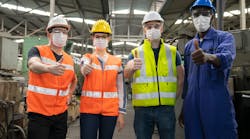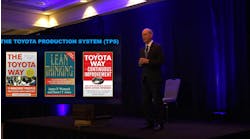Who can forget those early, confusing, and scary days of the COVID-19 pandemic? Overnight, our world changed. In the midst of this unknown world with very real fears, everything screeched to a halt.
The COVID-19 pandemic was a wakeup call in many ways. When the factories, flights, people and systems that power our global supply chain and economy stopped, our dependency on this logistical ecosystem became a vulnerability. Many who had never given a second thought to where our basic appliances came from were Googling “supply chain problems,” making this phrase among the most searched terms in 2021.
With newly focused attention on supply-chain availability and resilience, U.S. manufacturing is at an inflection point. The recently passed infrastructure and CHIPS acts enable direct investment of billions of dollars into the manufacturing sector responsible for critical components, again to improve capacity and supply certainty. According to an analysis by the McKinsey Global Institute, the manufacturing sector was already on an upswing between 2010 and 2019, adding 1.3 million manufacturing jobs to the economy, following the loss of 5.8 million jobs over the previous 10 years.
This is good news. Manufacturing matters to the United States because it provides “high-wage jobs, commercial innovation (the nation’s largest source), a key to trade-deficit reduction and a disproportionately large contribution to environmental sustainability,” according to the Brookings Institution. Continuing the positive momentum behind manufacturing will be transformative for this country.
For me, the CEO of one of Chicago’s largest manufacturing operations, the future of manufacturing and the opportunities our sector represents is personal. Unlocking that future requires a focus on sustainability, diversifying the workforce and nearshoring. With an average tenure of 11 years*, S&C team members can expect long, fulfilling careers. And because we innovate, design and manufacture technology for advancing a more reliable and resilient electrical distribution grid, our work is both essential and important as the world transitions to lower carbon sources of energy, like renewables and electricity.
Sustainability
Manufacturing is imperative to achieving global sustainability goals. In the U.S., manufacturing accounts for about a quarter (23%) of direct carbon emissions, according to the U.S. Environmental Protection Agency. Following China, the U.S releases the highest percentage, 12.6%, of total global emissions.
At S&C, we drive positive environmental outcomes throughout our products’ life cycle, from design through manufacturing, operation, upgrades, and end of life. In the world of 21st century manufacturing, we are minimizing waste, limiting our emissions of greenhouse gases and volatile organic compound, and keeping solid waste out of landfills.
Nearshoring
We must also not forget about the emissions associated with the logistical process of shipping goods long distances. According to the International Maritime Organization, cargo-ship emissions account for 3% of the world's total annual emissions. The Environmental Defense Fund says freight-truck movement is responsible for 7% of all industry greenhouse gas emissions in the U.S.
Onshoring and regionalizing manufacturing will reduce the need for long-haul shipping. At the same time, cleaner and greener manufacturing processes can further reduce environmental impact. Finally, manufacturing also has broad social and economic implications because it can provide economic security for the country and financial security for a diverse population.
Diversity, Equity and Inclusion
Manufacturing is the fourth-largest employer in the United States, and it can be a bellwether for economic growth and environmental stability. At S&C, we want people to know and recognize that manufacturing offers meaningful, long-term rewarding careers. We need dedicated, enthusiastic team members to advance the 21st century power grid. Beyond that, we must view manufacturing through a broader lens of what it can do for gender and racial economic disparity, what it can do for people from different educational backgrounds and for what it can do for people from disparate parts of the country.
Manufacturing employs people of different genders and of different educational and racial backgrounds, and it supports jobs for workers and communities across the continent, offering solid economic opportunities that are skills-based rather than degree-based. According to the Brookings Institution, manufacturing apprenticeship programs and internship programs can create greater economic opportunities for a wider segment of the population than apprenticeships in any other industry.
Are we there yet? Not quite, but we in manufacturing like to solve problems. In the past, we have successfully built cultures around safety, quality and integrity. Now we are doing the same to become greener and more diverse.
As an industry, we need to do our part to attract more women, minorities and younger generations to the manufacturing workforce. This requires a comprehensive plan, with broad-based diversity, equity and inclusion programs—and with commitment from leadership for those programs.
Manufacturing has long been the foundation of the U.S. economy. With continued investment and collaboration, and sustainable, we can address pervasive supply-chain issues, provide environmental stewardship and leadership through a shift to renewable energy and electrification and provide jobs that unlock career and economic opportunities for more people.
If we can do this, manufacturing offers perhaps our greatest opportunity at success in building a more economically resilient, inclusive and sustainable society.
Anders Sjoelin is CEO and president, S&C Electric Co.
*The original article erroneously stated 22 years.




